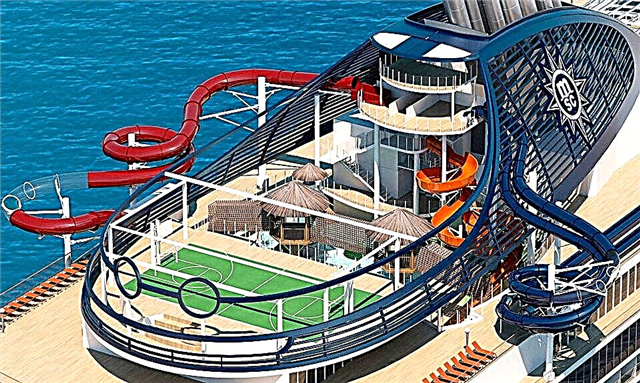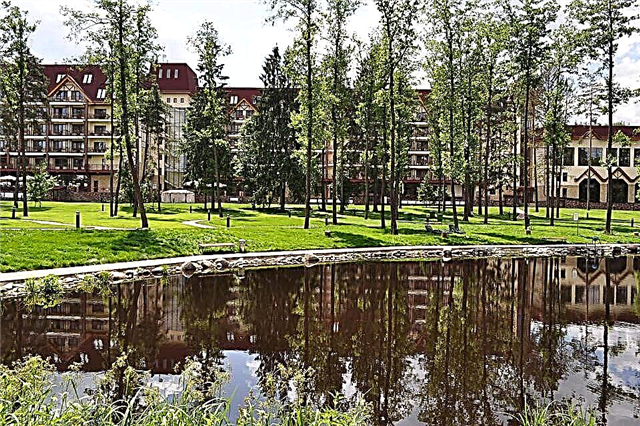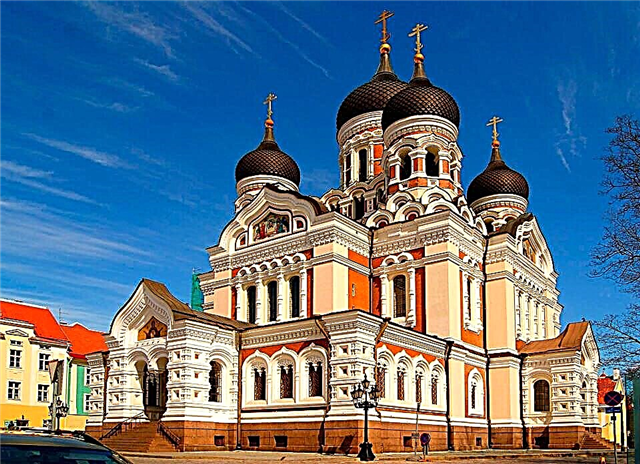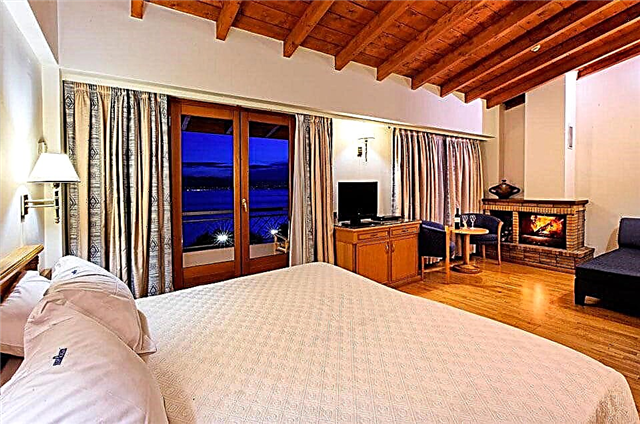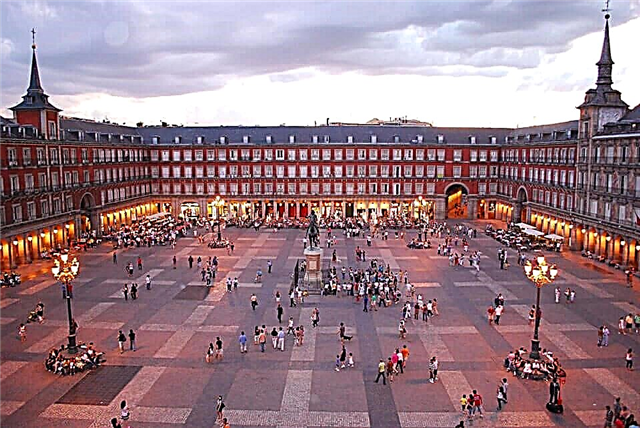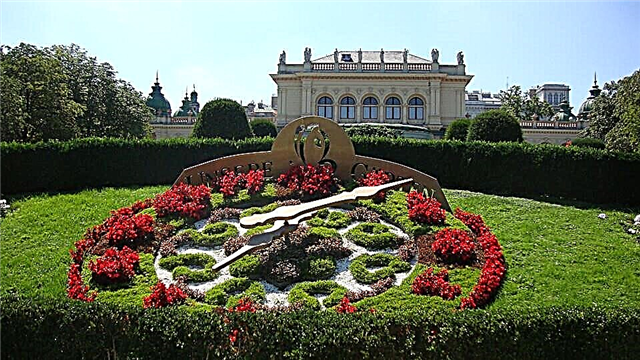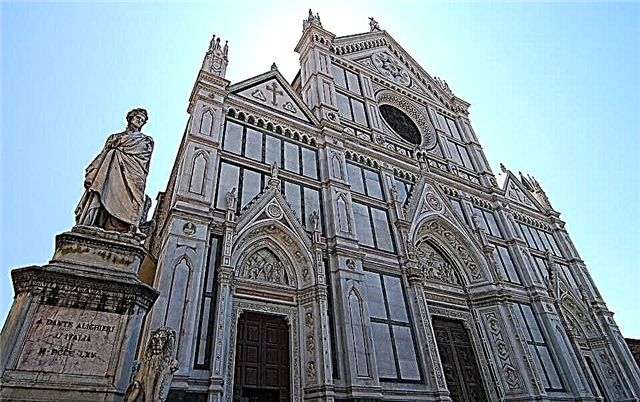Almost every major tourist city has its own architectural symbol: the Eiffel Tower in Paris, Big Ben in London, the Hermitage in St. Petersburg, the Colosseum in Rome, the Basilica of Santa Croce in Florence ... Basilica of Santa Croce (in other words, the Basilica of the Holy Cross) - one of the most beautiful and famous buildings in Florence. This is the first and largest Franciscan church in the world, in addition, it is known for the frescoes of the legendary Italian painter Giotto and the tombs of iconic figures of Italian art and science: Leonardo Bruni, Galileo Galilia, Nicolo Machiavelli, Michelangelo Buonarotti are buried here, as well as several memorial plaques and cenotaphs.
The first stone of the future basilica was laid at the end of the 13th century, and therefore the history of the foundation and construction of the church has survived to this day in semi-mystical colors, but this only gives it charm and mystery.
Construction history

There is a beautiful legend that the first stone of the Basilica of Santa Croce was laid by Francis of Assisi himself - the canonized Catholic Italian saint, who founded the same world-famous Franciscan Order, or the Mendicant Order. Unfortunately, this legend breaks down on the real state of things: Francis could not lay the first stone of the church, because he died in 1226, and the basilica began to be built only in 1294. Nevertheless, it is possible that Francis laid the first stone of a small church that stood on the site of the basilica earlier, at the beginning of the 13th century. But this is just an assumption, since no documents confirming this fact have survived.
But it is known for certain: the church was built by the followers of Francis, the Franciscan monks. By that time, their Order had already grown quite strongly, and the monks did not fit in a small church. The honor of becoming the architect of the new temple fell to Arnolfo di Cambio - later it became his greatest and most important architectural work.
They spent a lot of money on the construction of the temple: firstly, at that moment the Ghibellines were expelled from Florence - representatives of a kind of political opposition of those times, and their fortunes remained within the city limits, and the authorities reasonably distributed this wealth, including detaching some money for the construction of new temples and churches. In addition, the inhabitants of Florence themselves donated considerable sums: as representatives of the middle class - artisans, merchants, merchants, wealthy peasants - so did the entire nobility and the aristocracy. The latter gave the Franciscans huge sums in exchange for the right to have in the temple under construction named, family chapels: Bardi, Peruzzi, Castellani, Baroncelli, Medici - all these noble families invested heavily in order to remain immortalized within the walls of the temple.
The site for the construction of the basilica - the district of Santa Croce - was not chosen by chance: at that time the poor lived here - the ideal flock for the Mendicant Order. Later, craftsmen and builders who participated in the construction of the church began to settle here. Historians claim that later the Franciscans fought a real war for the parishioners with the Dominicans and won. This is due to the numerous frescoes that adorn the vaults of the Basilica of Santa Croce. For the illiterate poor, the drawings on the ceilings and walls were like Holy Scripture: a visual history of major religious events in pictures, which is why they chose the Franciscan cathedral.
The interior of the basilica was painted by Giotto, Giovanni da Milano, Mazo di Banco and other famous Italian artists. The construction itself lasted a long time, almost a century, presumably until 1385. The consecration of the Basilica of Santa Croce took place only in 1443.
The temple has its own black page in history: in 1966, there was a severe flood in Florence, in some areas of the city the water rose five meters above the usual level, flooding houses, public buildings and temples. The Basilica of Santa Croce also had a hard time: individual masterpieces of art were hopelessly spoiled. Fortunately, most of them were still restored, but something was lost in the water.
It should also be noted that initially there was a monastery at the temple, but at the end of the 18th century it almost outlived its usefulness, and at the end of the 19th century the city authorities decided to equip a museum there. Now the museum complex has grown so much that an attentive tourist will need almost a whole day to thoroughly examine it. Over the past two centuries, the Basilica of Santa Croce has become a real center of tourist pilgrimage and even appeared several times in popular culture, for example, in the cult computer game Assassin's Creed II.
Architecture

The original architectural style of the building was Gothic, but some parts of the temple were rebuilt or completed over several centuries, so the current appearance of the basilica retains the skill of architects and artists from several historical and cultural eras.
Built in the 13-14th centuries, the temple is still the largest and most impressive Franciscan building. All its constituent parts - the snow-white façade and the interior vaults ennobled with frescoes, the southern and northern naves, sixteen named chapels, the main altar, tombs, cenotaphs, memorial plaques - retain the pride and grandeur of bygone days. It is impossible not to admire the beauty and wealth of the Basilica of Santa Croce.
Timed admission ticket for Michelangelo's David - 16 €
Admission ticket to the Uffizi Gallery - 20 €
Uffizi Gallery: Priority Entrance € 40
Florence Cathedral: ticket with entry to the dome - 29 €
Entrance ticket and audio guide to Palazzo Vecchio - 19 €
Hop-on Hop-off tour. Ticket for 24, 48 or 72 hours - from 23 €
Leonardo da Vinci Museum: entrance ticket - 7 €
Tour to the Duomo with a guide and ascent to the top of the dome - 40 €
Entrance ticket to the Basilica of San Lorenzo - 8.50 €
Hot air balloon flight over Tuscany: Florence - 250 €
Facade
The original facade of the basilica was very simple and uncomplicated, one might even say it was absent: no one specially decorated the outer, front side of the temple. Only in the 19th century, when the temple underwent another rebuilding, Nikolo Mattas took over its appearance. Before that, he had already designed the facades of several Gothic churches, it is not surprising that the honor to put in order the Basilica of Santa Croce fell to him.
However, Mattas decided not to make the design too pretentious and pretentious: laconic marble whiteness, three arched spans, life-giving crosses, the Star of David (a kind of tribute to the architect's Jewish origin), graceful reliefs and sculptural modeling - nothing superfluous. Probably, this is how, modest and noble, the facade of a truly great temple should look like.
By the way, Mattas hoped that he would be buried somewhere near Machiavelli and Buonarotti for his services to the basilica, but the Franciscans were not ready to put a sarcophagus with a deceased Jew under the arches of their Catholic church. As a result, Mattas was buried in the territory of the basilica, but not in the church itself, but in a small courtyard.
Interior decoration

But inside the Basilica of Santa Croce - this is a real loud, majestic, magnificent ode to the Italian Renaissance and Proto-Renaissance and not only. There are so many frescoes, paintings, stucco moldings, stained-glass windows and other artistic and decorative elements that were once created by the hands of the greatest masters: a novice tourist's eyes will certainly run in different directions. The Basilica of Santa Croce has three naves, separated by graceful arches and rows of massive columns.The main, central nave is slightly higher than the side naves, but the South and North ones amaze with their rich decoration.
South nave
What is located in the southern part of the temple:
- sarcophagi Hugo Foscolo (poet and linguist), Gioachino Rossini (famous composer), Leonardo Bruni of Arezzo (scientist and writer), Nicolo Machiavelli, Vettorio Alfieri (tragedian playwright and poet), Francesco Nori (prelate), Michelangelo Buonarotti
- several paintings: "Christ in the Garden of Gethsemane", "The Scourging of Christ", "Behold the Man", "Ascent to Calvary", "Crucifixion" and some others
- cenotaph (empty, symbolic sarcophagus) Dante Alighieri
- Chair of the Italian Renaissance architect and sculptor Benedetto de Maiano, whose intricate and graceful bas-reliefs tell the story of the life of the patron saint of the temple, Francis of Assisi
North nave
What is located in the northern part of the temple:
- sarcophagi Carlo Marsuppini (humanist), Vettorio Fossombroni (politician and economist), Vettorio and Lorenzo Ghiberti (sculptors), Galilio Galilei;
- the fresco "Ascension of Mary" by the Italian painter Agnolo Gaddi;
- several paintings: "Dinner at Emmaus", "Resurrection of Christ", "Lamentation of Christ", "Ascension of Christ", "Descent from the Cross" and some others.
Chapels

There are sixteen chapels (sixteen chapels) in the basilica. Most of them are nominal, belonging to one or another rich and influential family of medieval Florence. In fact, a chapel is like a separate, independent small church, while being part of a large temple or temple complex.
The chapels of the Basilica of Santa Croce are separate works of art. Unfortunately, some of the frescoes by Giotto have not survived, because in the Middle Ages the bubonic plague raged in Florence several times, the temple was used as a hospital, and the luxurious frescoes were simply covered with whitewash. The plague, by the way, was so cruel to Florence that many Europeans called it Florentine, and Giovanni Boccaccio and Francesca Petrarca mentioned it in their famous works.
Donatello's crucifixion
The famous wooden Crucifixion by Donato di Niccolo di Betto Bardi is one of the main attractions of the temple. This work is notable for the fact that it is early in the work of the Italian sculptor and in some way copies a similar work of Donatello's teacher, Lorenzo Ghiberti. Depicted crucified on the cross, Jesus Christ is muscular, desperate, languishing, but at the same time, as if not expressive enough. What is the reason for this inexpressiveness - culturologists are still arguing. Most likely, the point is that Donatello was just starting his creative search at that time.
Main altar
The main altar of the Basilica of Santa Croce is a truly grandiose sight. Decorated with frescoes by Agnolo Gaddi, it is a living book of biblical stories: here is the Archangel Michael, giving Seth a branch of the Tree of Knowledge, and Seth himself, planting this branch on the grave of the late Adam, and the Queen of Sheba, and the terrible moment of making the Cross for the crucifixion of the Lord, and St. Helena, and the capture of Jerusalem ... All frescoes are detailed, detailed, carefully drawn. You can look at them for hours.
Agnolo Gaddi is also the author of the stained glass windows of the Main Altar. Bright, colorful, colorful, they are specially positioned to let in sunlight and in a bizarre, mesmerizing magical way illuminate the Main nave and all the interior decoration of the temple. The altar polyptych depicts the Madonna and the saints. Even higher is the "Crucifixion" by an unknown author, presumably - Figline.
Castellani and Baroncelli Chapels

These two chapels were painted by Gaddi's son and father: Agnolo and Taddeo. The family chapel of the Castellani family is a whole series of eerie and frightening plots: here is a dragon devouring a baby, and Apollonia, whose tormentors brutally knock out her teeth, and a commoner crushed by a cart. Where so much violence comes from is unclear, cultural scientists find it difficult to answer this question. In the second chapel, the frescoes are more peaceful: most of the paintings depict the life of Mary.
Chapels of Bardi and Peruzzi
The Bardi Chapel is one of the first chapels of the Santa Croce Basilica. It was built at the beginning of the 14th century. It was painted by Mazo di Banco, the story depicted in the drawings is the life of Saint Sylvester, the former Pope of Rome, and some other saints.
The Peruzzi Chapel is perhaps the most famous in the temple, because its walls were painted by Giotto himself (the biographies of St. John the Theologian and St. John the Baptist), in addition, it is here that Michelangelo and Galilio are buried. Initially, there were four similar chapels on that side of the temple, but, unfortunately, only two of them have survived.
Medici chapel

The Medici are by far the most famous Florentine dynasty. From this family came as many as four popes, as well as two queens of France - Catherine and Mary. It is not surprising that the Medici chapel is perhaps the most luxurious and rich in the basilica. It was decorated by Michelangelo Buonarotti himself, and this is considered one of his best works.
Tombs of the great men of Italy

There are more than three hundred graves in the Basilica of Santa Croce. All people who are buried here are famous Florentine and Italian politicians, public figures, philosophers, painters, sculptors, architects, musicians, writers, poets and scientists.
The most famous of them:
- Michelangelo Buonarotti, one of the greatest masters of the Renaissance; was born in 1475 near Florence, in sunny Tuscany, and lived for almost 90 years, leaving behind an immense artistic legacy
- Nicolo Machiavelli, philosopher, thinker, writer, diplomat; was born and died in Florence; from a young age he was fascinated by the works of such great minds as Titus Livy, Flavius, Cicero, Plutarch, Aristotle, in 1532 he published his own famous political and legal treatise "The Sovereign"
- Galileo Galilei, mathematician, physicist, astronomer; he was the first scientist to observe the movement of celestial bodies with a telescope, and also became the founder of classical mechanics; in the last years of his life he had a serious conflict with the Catholic Church, which, however, did not prevent the Franciscans from burying him within the walls of a Catholic church
The name of Dante Alighieri, the famous native of Florence and the author of The Divine Comedy, stands apart. At one time, the writer was expelled from his hometown in disgrace and wandered for a long time: Verona, Bologna, Paris, Venice, Ravenna. In Ravenna, he eventually settled, lived the last years of his life and died of malaria.
Only after the death of the writer did Florence realize what kind of genius she had lost. The Florentine authorities tried to demand from Ravenna the release of the ashes of Alighieri, but Ravenna refused. The dispute over who has more rights to the poet's remains is still going on, and in the Basilica of Santa Croce there is an empty sarcophagus prepared for Alighieri, if his ashes suddenly return home one day.
Opening hours and ticket prices

Opening hours of the Basilica of Santa Croce:
- Mon-Sat 9.30 am-5.30 pm
- Sun 14.00.-17.30
- January 6, August 15, November 1, December 8 14.00.-17.30
Ticket prices:
- adult ticket - 8 euros
- child ticket (11-17 years old) - 6 euros
- children under 11 years old - free
In addition, an audio guide can be rented from the basilica (audio tour is available in several languages). It will cost an inquisitive tourist another 1.5 euros.
Where is it and how to get there
Piazza Santa Croce, 16 - any Florentine will tell you how to get to this address: for foreign visitors, the Basilica of Santa Croce is one of the main places of tourist and religious pilgrimage. There is public transport (for example, bus routes C1, C2, C3, 23) and taxi drivers are happy to drive, in addition, you can reach the basilica on foot: just 20 minutes from Florence train station.It is almost impossible to miss the attraction: not only is it located in the historical and cultural center of the city on the huge square of the same name, but it also attracts attention with its impressive size.
In addition, in the square in front of the Basilica of Santa Croce, various events are often held, which are also impossible to pass by: theater and music festivals, concerts, matches of the famous medieval Florentine football, more like a spectacular costume show than a sports game.
Every tourist should visit the Basilica of Santa Croce in Florence, because it is the unconditional quintessence of the centuries-old historical and cultural layer of Italy, and just an incredibly beautiful, rich, majestic, peaceful place.


